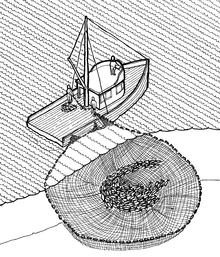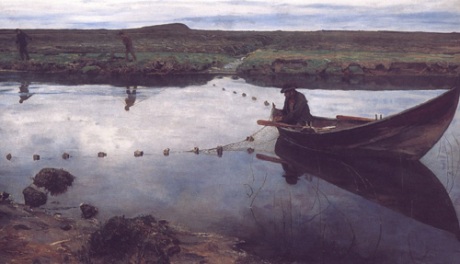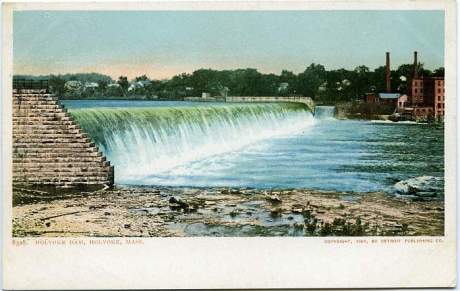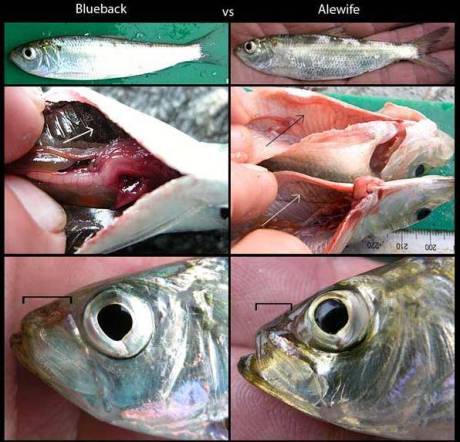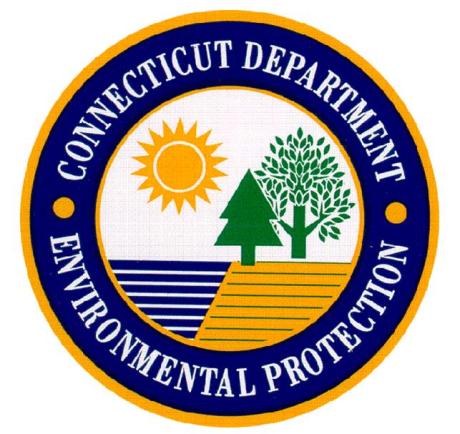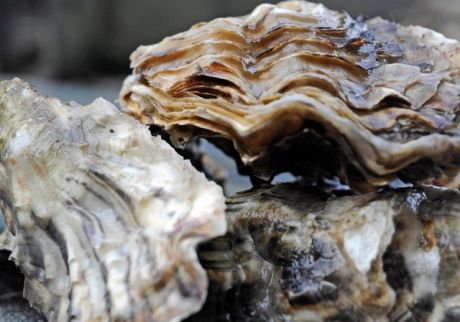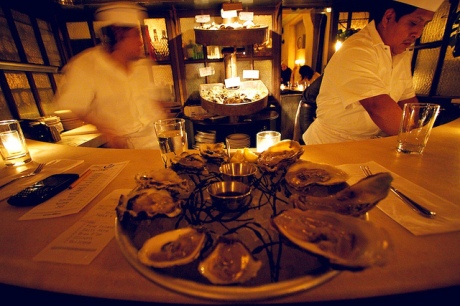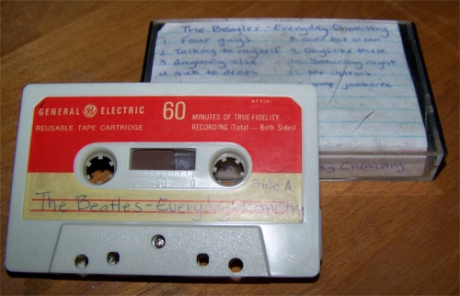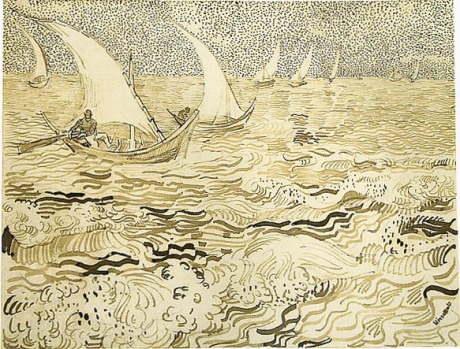Ode to Restaurant SEO
April 15, 2011
My favorite place for a relaxing and restorative respite from running through the gauntlet of a hard day’s work here in midtown Manhattan, Restaurant SEO offers an unparalleled combination of value, quality and consistency: a virtual trifecta of delicousness.
If this all comes off as superlative, so be it. Let the Good Herring further qualify the virtues of this enclave of Japanese culinary authenticity by illustrating two key reasons to believe:
Point 1: The lunch special
$12 affords you the choice between three delicious specials. 1) broiled mackeral (pictured above), 2) eel over rice, 3) chirashi. Though you can’t go wrong with either of the selections, it’s the chirashi that never fails to send me into a spiral of epicurean ecstacy. Layered atop a pillow of perfectly cooked rice, ever-so-lightly tinged with the sweet tang of rice wine vinegar, the featured sashimi selections–which change according to market availabilities–are consistently of the highest caliber. Today’s selection included a generous total of 8 slices of sashimi: tuna (maguro), salmon, yellowtail, snapper, fluke and sea urchin along with a thick slab of egg omelette. Oishi.
In an effort to ensure the corners of your appetite are fully rounded out by meals-end, the lunch special is always accompanied by a modest portion of delightfully crunchy vegetable tempura and a bowl of miso soup, which, in the case of Restaurant SEO, somehow elevates it’s ubiquitous role in Japanese restaurants to a higher level.
Point 2: The ambiance
Ah, to be sitting in Restaurant SEO’s comfortable wood-paneled dining room, sipping green tea from a glazed earthenware cup, gazing out upon a traditional rock garden, perhaps catching tasty notes of Brazillian-influenced jazz playing between the soft pitched conversations of fellow diners.
Located at 249 East 49th street between 2nd and 3rd avenue, Restaurant SEO attracts an interesting blend of multinational clientele, owing likely to its position within walking distance from the United Nations. As such, the flowing cadence of Japanese being spoken are as frequently juxtaposed by the lilting sounds of French or German.
In a bit of a departure from the traditional Japanese aesthetic, autographed photos of famous Yankees line the walls of the stairway down to the bathrooms downstairs. Though seemingly out of place in SEO’s Zen-like confines, the Good Herring (a New York Met fan, for the record) surmises their presence was a subtle nod to former Yankee World Series MVP and Japanese ex-pat Hideki Matsui who used to be a frequent customer…maybe it was the lunch special?
Ecological Biomass
March 24, 2011
TGH came across an epic Herring-centric video clip within the BBC program, Nature’s Great Events. A particular episode, entitled ‘Nature’s Great Feast’, touched on the concept of how some living organisms (like Herring) have learned to group together to defend their species against the many predators they face.
Now, herring may be of a diminutive size, but along with swimming in massive schools, they also have a number of other Darwinian tricks up their proverbial sleeves (gills?) that help them avoid becoming supper in the wild. One of these naturally selected traits is an obvious reason for their nickname, “silver of the sea” or “silver darlings”. Herring have an incredibly effective camouflage that uses embedded crystals within their bodies to create a glistening effect, mesmerizing would-be prey and keeping them concealed in the glistening currents.
Herring may have a pseudo cloaking effect and seek to find power in numbers, but those strategems only go so far. Nature always has her trump card, and it’s often at the top of the food chain as you’ll see at the :40 mark of this footage.
Check mate.
Cecil Herring: 80 Years of Very Cool Art
March 22, 2011
This Friday, March 25th, Central Florida multimedia artist Cecil Herring will celebrate her 80th birthday and over 50 years as a working artist with a retrospective show of her works at the Riverhouse Gift Gallery in Sanford, FL.
I just found out about Cecil’s oevre of paintings, sculpture and wearable art, and I must say, the good herring can dig it. Of course she’s got a great last name, but after learning that she’s a fellow U.C.F. alumni, well, I totally feel compelled to promote this awesome artist’s big retrospective gallery show!
So if you’re reading this and in the Central Florida area, why not head over to check out Cecil’s solo show and wish her a happy 80th birthday…refreshments will be served! If you can’t make it this Friday however, definitely do yourself a favor and check out her super heady website: spacescapes.com
Tsunami Spells Trouble For BC Herring Fisheries
March 17, 2011
Herring season has kicked off in the waters around Vancouver, British Columbia, though while local fishermen report that there are plenty of herring to be caught, apparently this year’s run of silver darlings are on the tiny side.
That means that commercial ‘seiners’, large boats that corral entire schools of fish into their purse-like nets, are rendered useless–the tiny herring are too small for their nets!
With the seiners down for the count, ‘gill netters’, local fishermen with comparatively smaller boats (and likewise smaller nets) can get a leg up on the herring fishery.
Tiny fish means less profits however, and these local, hard working Herring fishermen invest much time and resources in their efforts to get a taste of the silver darlings.
The bulk of West Coast herring are usually procured immediately (and with gusto) by the Japanese market, likely sent overnight to Tsukiji Market in Tokyo to be sold to the very next morning. This is no usual week for Japan, however. As the nation and its allies struggle to manage the fallout from the Tsunami that struck eastern Honshu last week, Japan’s economy and infrastructure has been torn and frayed. As the sun will surely rise tomorrow, the Japanese people will also recover from their current predicament. In the meantime, Vancouver’s herring fishermen can only hope for the best.
The socio-economic implications of the natural disaster that struck Japan are far-reaching indeed. So far reaching in fact, that the local herring fisherman of British Columbia have lost (albeit temporarily) their primary buyer of the fish that supplies their livelihood. Perhaps this blog will inspire some more Americans to eat domestic herring and help these fishermen out!
If you’re in a pinch for a good way to prepare herring, I’d recommend you listen to the words of wisdom spoken by the gentleman featured at the 2:00 mark in the below video clip…”salt ’em, pickle ’em, make rollmops and all kinda schtuff!”
Plight of the Alewife
March 14, 2011
Since 2002, states along the East Coast have all experienced dramatic declines in river herring populations.
As a measure of protection towards offsetting this decline, The Department of Environmental Protection today announced that the prohibition on the taking of Alewives and blueback herring from most inland and marine waters of the State of Connecticut has been extended for another year.
What is an Alewife you ask? Commonly dubbed River Herring, Sawbelly, Gaspereau, Golden Shad and even Gray Herring, this herring doppelganger’s true identity is well known to latin-speaking marine biologists worldwide: Alosa Pseudoharengus (pseudo “false”, harengus “herring”).
In a side-by-side comparison, you’ll see how similar these species are. It’s very difficult to separate Alewife from blueback herring without rolling up your sleeves and digging in…literally. As you can see, the lining of an Alewife is pale to lightly pigmented while that of a blueback’s is jet black. Interior color notwithstanding, Alewives, like Herring, are eaten fresh, dried, smoked, or fried and their eggs (roe) are considered a delicacy.
Let it be said that humans aren’t the only ones that enjoy a tasty snack in Alewives and Herring. These river-dwellers constitute a significant food source for indiginous marine gamefish, as well as osprey, bald eagle, harbor seals, porpoise, egrets, kingfishers and river otter. That’s a big reason why protecting the species is of vital importance.
As the constant reader will know, these fish species are anadromous, which means they hatch in freshwater, migrate to the ocean to grow, then return to freshwater to spawn.
Historically, millions of river herring returned to Connecticut rivers and streams each year. In 1985, over 630,000 blueback herring passed over the Holyoke Dam, on the Connecticut River. By 2006, only 21 passed the Holyoke Dam (Massachusetts), the lowest number in the history of the Holyoke Fishlift. Last year that number had risen only to 76.
While the reasons for these historically low levels (and the methods by which these levels are ascertained) are not fully understood, the importance of protecting river herring runs as a means of conserving the indigenous ecosystem is clear.
Kudos to the acting DEP Deputy Commissioner Susan Frechette for making inroads to this cause and taking the initiative to extend the fishery closure and long live the good herring!
$1 Oysters @ Maison Premeire
March 13, 2011
In serendipitous fashion following my post this past Friday afternoon, Mason Premiere announced an ongoing Oyster Happy Hour!
Every day between 4pm – 7pm, oysters (and clams) can be had for a trifling $1.
Laissez les bon temps roulez!
I ♥ The Big Oyster
March 11, 2011
The infamous melting pot–a microcosm of the American identity–New York is home to a confluence of cultures the likes of which are not to be found anywhere else on earth.
One of the many fringe benefits of this unique ethnic smorgasbord is the veritable cornucopia of authentic and amazing epicurean delights readily available to the average New Yorker at any given moment in the day. The stomach of the city that never sleeps is always hungry. Fortunately, you don’t have to be rich to partake in many of the gastronomic highlights endemic to New York City. The price of a slice of authentic New York-style pizza for example, has always been roughly commensurate with the price of a one-way ticket on the subway.
That said, it’s not every day that locals think about the origins of New York’s food culture. You have to go way back in history to get at the root (or shall I say bed) of the matter, and that’s precisely what Mark Kurlansky, author of The Big Oyster: A History on the Halfshell does in his amazing etymology of New York City’s long standing relationship with a certain bivalve.
I love oysters. The variances in texture, salinity and sweetness are a delight to the connoisseur’s palate. The many varieties, locally sourced from distant ports of call often feature whimsical, nautically-themed appellations (eg: “Salty Aire”, “Wellfleet”, “Blue Point”) evoking memories of past travels and dreamlike imagery of seafaring destinations yet to be reached. The common denominator between them all though, is a collective coastline. The frothy ocean that feeds the brackish waters serving as a womb to the oyster, laps at these shared shoals from Eaton’s Neck, NY to Essaouira, Morocco alike. It makes perfect sense then, that in a word, oysters taste invariably like the sea.
Humankind has a historical precedent for building communities near the sea, and New York City is one of, if not the greatest clusterings of seaside human civilization ever. Manhattan’s original residents, the Lenape tribe, had a particular (and understandable) affinity for one of the most plentiful and readily attainable food sources available in the brackish inlets clustered around the Hudson Bay. The first Europeans to visit modern day NYC couldn’t believe their eyes when they saw the primordial size of the local oysters, which according to Dutch visitor Adriaen van der Donck, were over 12” long! That’s apparently the result of millennia of sustainable oyster harvesting.
In the centuries following the colonization of the new world, the local appetite for oysters was only matched by Manhattan’s booming population. A food of the people, for the people, New York’s oysters were a staple dish found on the tables of the rich and the poor alike. It wasn’t long however, until the burgeoning pace of industrialism—so intrinsic to the rise and continued glory of New York itself—dealt a near fatal blow to the oyster population of the Hudson Bay, rendering them unfit for human consumption.
Fast forward to today, the estuaries of New York harbor are making somewhat of a comeback from an environmental health standpoint. Although I still wouldn’t eat an oyster I found clinging off the docks behind the IKEA in Red Hook, local New York oyster populations have regained a foothold in some unlikely places. In June of 2010 this fantastic article about efforts to educate local youths about the important role of oysters in New York’s aquaculture history was featured in the New York Times:
At the New York Harbor School, Growing Oysters for Credit
All this talk about oysters is making me hungry. I think a visit to Maison Premiere, a rather awesome-sounding New Orleans-themed oyster and cocktail bar that recently opened in Williamsburg, Brooklyn, is in order! I’m definitely looking forward to sampling a variety of their finest oysters accompanied by a cold local brew sometime this weekend…my review (along with some more pelagic musings for all you loyal readers) is forthcoming in the next installment right here at The Good Herring. Cheers!
Over The Ocean
November 23, 2010
I recently read an intriguing story about the Beatles on the Internet (so, therefore it must be true).
The tale chronicles the misadventures of a mysterious chap named James Richards and how he came into possession of a never-before-heard Beatles album dubbed “Recreational Chemistry” through an incredulous chain of mind-bending events.
So the yarn goes, James and his dog were driving through a long stretch of highway in the California desert when they stopped for a rest. The dog must have caught the scent of something as it took off running. As fate would have it, James fell into a rabbit hole while chasing his runaway dog (who was, you guessed it, chasing a rabbit), and wound up knocking his head upon a rock, rendering himself unconscious.
Upon waking, he found himself–get ready for it–in a parallel universe, sitting in the living room of a good samaritan who happened to be a huge Beatles fan. The funny thing is that in this parallel universe, the Beatles never broke up.
To make a long story short (TOO LATE!), the hero of this story was safely delivered from this parallel dimension and returned back to his familiar Californian homeland, but not before he nearly disrupted the space-time continuum by stealing this trans-dimensional bootleg from the dusty stereo in his savior’s home. The pervasive guilty feelings that linger after committing such an act were only further substantiated by the stern, disapproving looks he received from his dog, who sat quietly in the passenger seat on the long and winding road back to his home.
In retrospect, I’d say his time-traveler bungle was a worthy sacrifice. Beatles fans around the world can now rejoice at the realization of this never before heard intergalactic chestnut entitled, “Over the Ocean”!
This one goes out to my Pacific brahs: one is leaving on a flight tonight, bound for the tropical paradise that is Hawa’ii. He’ll be lucky to spend Fatsgiving with none other than the Big Kahuna himself, paniolo of Oahu and devourer of the Humuhumunukunukuapua’a. Have da kine fun dudes!
Many happy luaus to all this Thanksgiving!
Pelagic Musings
November 17, 2010
I’ve revisited and refined my original mission statement in an effort to establish a definite theme for the various editorial pieces found here at The Good Herring.
Henceforth, content found within this blog will fall under a “pelagic” motif. The word pelagic comes from the Greek πέλαγος or pélagos, which means “open sea.”
An oceanographer might consider the pelagic zone as an imaginary cylinder of water that reaches from the surface of the sea almost to the bottom, encompassing most forms of seaborne life.
With respect to this blog however, it basically translates to the fact that all future editorial content will–to some degree–pertain (or have some roundabout connection) to the ocean.
This new focus will establish a clear thematic relevance to the content found here. Ideally, it will also provide structure for me (the writer), from a creative perspective, while conversely improving the general experience for you (the reader/searcher); this way, you’ll know what to expect the next time you visit!
Doncamatic Style
November 16, 2010
Check out this great new aquatic-themed video from Damon Albarn and his troupe of animated ice pirates, the Gorillaz.
The video accompaniment to the bands’ new single documents the obstacle-ridden underwater journey of a sassy soul singer named Daley in his one-man rave-up of a submarine. The coordinates for his secret destination were locked-in at launch; Daley completes his mission in posh style, surfacing safely at Gorillaz HQ on Plastic Beach. If only that submarine came as a two-seater!
Keep your eyes peeled for the herring school and superfast jellyfish cameos…
The cartoon band’s Murdoc had this to say about the track:
“I actually found Daley washed up on Plastic Beach – covered in oil and singing to a seagull…or was it an albatross? Anyway, I recognise golden pipes when I hear em’ so I popped a bag over his head, hosed the boy down and chucked him in the studio with Noodle and her 8-track. I left them to it while I stepped outside for a Lucky Lung or three, and when I popped back in this is what they’d come up with! Am I a genius or WHAT?!?”
Doncamatic is released on November 22nd, 2010 as a 7” picture disc, CD single and digital bundle. Take your pick.





